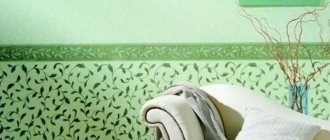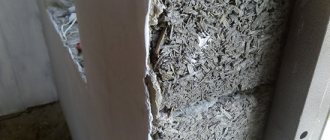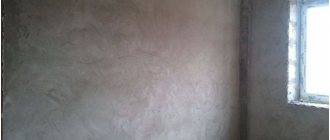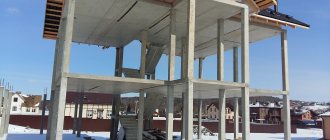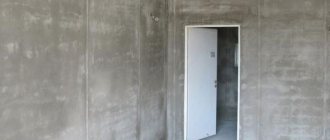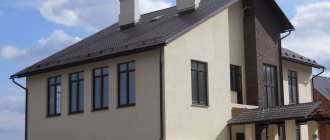After building a house from aerated concrete, its facade must be protected as quickly as possible from the harmful effects of atmospheric humidity. This urgent need is caused by the cellular structure of the material and, as a consequence, its high hygroscopicity.
Aerated concrete absorbs water very quickly and with the onset of cold weather can greatly lose its thermal conductivity, freezing. One of the most accessible and common methods of finishing aerated concrete is painting it. How effective such a layer is as protection, whether it is possible to paint aerated concrete itself, what paint to choose and how to apply it correctly, you will learn from today’s article.
Preparation
Porosity of the material is the main problem that needs to be solved. The first thing that comes to mind is plastering the walls: with its help you can achieve the evenness of the future surface. For leveling, different types of solution are used:
- Cement-sand plasters and their derivatives (lime, sand-lime);
- Gypsum compositions for treating the internal surface.
Before plastering the wall, it is carefully primed with a special deep penetration compound to reduce material consumption. It is recommended to make 2-3 passes with soil.
After applying the base layer of preparation, the finished wall is again treated with primer before finishing painting.
How to paint
Any special paints are suitable for painting the prepared surface: facade paints, for interior work. They can be made on the basis of acrylic, silicates, silicone. The technology for applying emulsions is standard:
- Painting begins from the window towards the door. You should not start work from the middle of the wall, as this can result in uneven paint transitions between working areas.
- The paint is applied with a roller on a long handle in the upward direction using stretching movements.
- To obtain the desired result, apply 2-3 layers of paint.
Non-standard approach
The classic algorithm is not always appropriate; perhaps painting the walls is a temporary measure to create the appearance of the house. In this case, how to paint foam blocks without plaster?
If plastering of the surface is not expected, you need to understand: the porosity of the foam block contributes to high moisture absorption. Thus, paint consumption can exceed 5 times compared to coating a plastered surface.
A mandatory step will be priming the walls with several layers of deep penetration primer. 2-3 applications will reduce the absorbency of the material, so you can reduce the cost of the dye.
Which primer for gas silicate blocks to choose
Many people are interested in which primer for gas silicate blocks is better? According to experts, the effectiveness of a primer depends on:
- Penetration depths;
- Climatic conditions (temperature, humidity);
- Features of subsequent finishing (siding, plaster, tiles).
Based on these factors, we can conclude that the most important thing in a primer is its ability to interpenetrate; accordingly, the most suitable option is a deep penetration primer for aerated concrete.
Products with a deep penetration effect are introduced into layers of foam blocks or gas silicate blocks, forming a moisture-resistant film on the base. Thus, providing the following benefits:
- The durability of the building increases regardless of the level of humidity in the rooms;
- The plastering process is simplified, the consumption of plaster mortar and paint is minimized, regardless of the composition and properties of the plaster itself;
- The adhesion of the finishing and its quality increases, regardless of the finishing material;
- The possibility of fungi appearing even in rooms with high humidity is eliminated.
Experts believe that the best result can be obtained if you use primer and plaster from the same manufacturer.
Is it possible to paint foam blocks with putty?
Another interesting way to finish a foam block is puttying. The plastered surface is treated with special compounds to make it more even. Most often, mixtures have a white color, which is convenient to apply under paint - it will not change or show through the shade of the base.
Sometimes thrifty owners do without plastering and immediately use putty. This option is acceptable for temporary covering of the facade - without the main leveling layer, the appearance of the house quickly loses its original appearance. A thin layer of putty is applied to the main wall, then paint.
Modern designers and craftsmen manage to kill two birds with one stone - when mixing the putty mixture, they add a construction color to the solution. This method is rare, but it does happen:
- The substance does not change the characteristics of the material and does not affect its solubility;
- The use of white plaster with color allows you to reduce work time by combining two stages.
True, there are several nuances of the technique:
- The solution must be thoroughly mixed. For the process it is necessary to use a construction mixer.
- To cover a large area, careful selection of shade is required: the solution is prepared in small batches, each shade must match the previous one so that there are no color transitions.
Puttying with a white or tinted mixture without laying a plaster layer or immediately painting the foam block is only suitable for creating a temporary external appearance of the house. Over time, the coating wears off, washes off and is absorbed. After 3-4 years, it is necessary to install a new facing layer.
Source
Plaster or putty?
If you ask any finisher whether it is necessary to plaster aerated concrete walls, in most cases you will receive an affirmative answer. However, it must be taken into account that specialists most often act according to an established technological map, which provides for a certain sequence of actions. For them, the finishing process almost always consists of plastering, puttying and applying the finishing coating to a flat, prepared surface.
Aerated concrete has a fairly even geometry. Compared to other piece materials (ordinary brick, cinder blocks or other similar materials), aerated concrete masonry has a flat plane. The only elements that require sealing may be seams and potholes that occurred during transportation or masonry. From a decorative point of view, it is quite possible to paint aerated concrete without plastering, only with partial spot sealing of seams or surface imperfections.
Is it possible to paint aerated concrete without preparation?
There are many corners inside the house that do not require too much finishing. For example, service or auxiliary premises, areas intended for cladding or cladding. In addition, painting of aerated concrete is often carried out as a temporary protective measure, during the shrinkage period (from 6 to 18 months after completion of masonry and installation of the roof). This period is quite long and requires some protective measures so as not to create conditions for early destruction of the material.
There are often statements that aerated concrete does not need to be cured - the material dries sufficiently during storage before sale. This is quite possible, but as a rule, there is no exact information about the date of manufacture of a given batch of blocks. In addition, the storage conditions of the material are important. If there was no opportunity for high-quality drying (for example, the blocks were stored in a cold warehouse and could not actively release moisture), the shrinkage of a house made of aerated concrete will occur as if the material had just been manufactured.
Temporary painting can be done without preparation, directly onto aerated concrete blocks. However, the process of laying aerated concrete is quite specific. It is often produced by people new to the technological requirements. Often, blocks are laid with poor-quality filling of the seams - if glue is applied to horizontal surfaces in a fairly even layer, then it is laid unevenly on the ends. If gas blocks have special protrusions (groove-ridge), careless builders often do not coat the joints with glue at all. Their reasoning is simple: the masonry does not show through, there are no complaints from the customer, everything is fine. However, the wasteland creates opportunities for the penetration of cold air flows from outside and the formation of cold bridges. A section of cold wall appears on which condensation begins to actively precipitate. Aerated concrete becomes saturated with water, mold and mildew appear, and the microclimate becomes uncomfortable. Therefore, preliminary putty is the minimum necessary finishing element that protects aerated concrete from getting wet and premature destruction.
What paint is suitable for foam blocks
Foam blocks have become increasingly used in construction due to their high performance qualities. The erected walls have an unattractive appearance - gray porous stone. The exterior decoration of a building made of foam blocks is of particular importance due to the structure of cellular concrete.
To decorate the facade, facing bricks, facade panels, siding and other options are used. Paint for foam blocks is an inexpensive and effective way to give walls a unique look.
Conclusion
As we can see, there are quite a lot of options for finishing foam blocks. Having considered their features, everyone will be able to choose the most optimal option for themselves, in accordance with their financial capabilities and personal preferences. The most important thing is that the foam block is protected, thanks to which the house will be warm and durable (see also the article “Finishing the inside of walls made of foam blocks: finishing options”).
For more information on this topic, watch the video in this article.
Features of the material influencing the choice of wall decoration
Foam blocks do not have high strength, they absorb water well, all this leads to destruction. When choosing possible finishing options, you should take into account a number of factors given in the table.
| No. | Characteristics of foam blocks | Finishing features |
| 1 | Strength | The selected type of finish must withstand mechanical and impact impacts. |
| 2 | Frost resistance | Do not deteriorate and maintain its original appearance from many cycles of freezing and thawing. |
| 3 | Vapor permeability | The finishing material must not interfere with air filtration. |
| 4 | Water permeability | Reliable protection against moisture ingress. |
Classification of facade paints
To decorate external walls, façade paint for foam blocks is used. You can find several types of paint on sale:
- structural, forming a relief coating;
- textured with reinforcing fibers;
- water-dispersed;
- rubber.
Textured and structural material has the following technical characteristics:
- No additional wall treatment is required; façade paints are easy to apply and roll out with a roller.
- Getting the desired color using a tint.
- Forms a matte relief coating.
- Hides minor surface defects.
- Has good vapor permeability.
- Textured paint with reinforcing fibers forms a coating that prevents cracks from forming.
- There is no unpleasant odor.
Painting walls made of foam blocks can be done without preliminary preparation, you just need to clean it from dust.
Water-dispersion paint “Tex” is suitable for painting external and internal surfaces of foam blocks. The surface must be coated several times. The painted base will “breathe”. It is convenient to apply the paint composition with a roller or brush.
Structural water-dispersion paint “Gasbetonbeschichtung RD10” has an acrylic base. Used for painting external and internal surfaces. The fine-grained structure is suitable for covering a porous base, which means it is ideal for sand concrete. The material has the following performance properties:
- high resistance to climatic precipitation;
- ideal for covering porous surfaces;
- high protection against shock and mechanical impacts;
- use for design decoration;
- good moisture resistance and vapor permeability;
- long service life - up to 20 years.
VD paint can be used for mineral bases or under synthetic plaster.
Rubber paint “Super Decor” is ideal for foam blocks. After painting, a velvety coating is formed. The use of paint and varnish material will allow:
- protect and strengthen walls;
- provide oxygen access;
- do not allow moisture to pass through;
- wash the surface with cleaning solutions;
- service life – up to 10 years.
Tips for application.
Experts recommend remembering the features that simplify application and increase the service life of the coating:
• the solution adheres more reliably to rough blocks; They are prepared by cutting. Facade plaster for aerated concrete fits much better on them. • on the outside and inside, the ratio of layers must be correct. Moisture should not be retained by the outer layer; free air circulation is important. If condensation accumulates there, then with temperature changes, the liquid will begin to freeze and expand, which will inevitably lead to cracking; • the first coating should be carried out by thin spraying and only after that the main coat is applied. This makes the grip much better.
Features of surface preparation for painting
It is recommended to paint external walls at a temperature of +20 degrees. It is not advisable to carry out work early in the morning. During this period, the façade of the building is wet from dew. The entire technological process can be divided into several stages:
- Preparing the base. The walls are cleaned of dust and dirt. Deep seams and irregularities are sealed. Cracks around door and window openings are smoothed out.
- Primer of walls. Treatment is carried out with anti-corrosion and antiseptic solutions. If the surface is coated with a primer, the paint will lie smoother and good adhesion to sand concrete will be ensured.
- Painting the base with paint and varnish composition.
Technology for plastering aerated concrete blocks
Plastering walls made of aerated blocks, as a rule, does not create problems, although it has features, knowledge of which is mandatory. The main thing is that during work you should adhere to the technology and comply with the requirements.
Surface preparation, primer
Since aerated concrete walls are smooth, there is no need to level them. And the glue used during installation will eliminate noticeable dents.
The work is performed as follows:
- Using an ordinary spatula, glue is applied to the recesses until the surface is completely flat. Excess material is removed.
- The seams are sealed in the same way.
- Shuffling is performed to get rid of minor flaws.
- The surface is treated with a fine brush to remove dust.
For aerated concrete walls, a strengthening primer with significant penetration is required. Then, after treatment, the surface will allow steam to pass through well, protecting the blocks from absorbing unwanted moisture. Another advantage of using a primer is the creation of better adhesion between aerated blocks and a layer of plaster.
Depending on weather conditions, apply one to three layers of primer. The coating is done with a roller, which allows you to make it uniform. In hard-to-reach places, use a small brush.
Reinforcement and application of plaster
Usually the mesh is installed on the solution (overlapping) and gradually deepens. Then, rubbing and leveling are performed with a spatula. If necessary, the required amount of plaster is added to completely cover the reinforcement. For corners, including those on window and door openings, special profiles are provided, and the rest of the work is performed in the same way. After installing the reinforcement and leveling the walls, you should wait until it dries.
A layer of plaster exceeding 1 cm is subject to reinforcement.
Plaster is applied to a previously prepared surface. If reinforcement is required, the processes are combined as the mesh is installed internally. You need to plaster and remove excess with a spatula. In unfavorable weather conditions, several layers of solution are applied, waiting for each layer to dry. Completion of plastering work occurs after the last layer has dried.
Tool
To carry out the work you will need tools and building materials:
- construction spatulas of different sizes and purposes;
- for painting rollers and brushes;
- painting cuvette;
- sandpaper with fine and coarse grains;
- construction hammer;
- pliers;
- putty composition;
- paint and varnish products.
Depending on the condition of the external walls of the facility, you may need:
- degreasing solution;
- to eliminate cracks and seal seams - gypsum;
- masking tape;
- stain removers for plaster.
Painting sequence
At the first stage of work, the walls are cleaned of grease stains, rust, dust and dirt. Identifies and eliminates foundation defects. To complete the work, you will need gypsum and putty to remove cracks and eliminate deficiencies in the foam concrete masonry.
After this, you can begin priming the surface. A roller and brushes will be useful for this work. The primer can be applied with a special sprayer. Material consumption is indicated on the packaging by the manufacturer or instructions.
Priming foam block walls will help reduce paint consumption.
After the walls have dried, they begin directly to painting. When performing work, it is recommended to follow the following sequence:
- Applying paint should begin on the corners and edges of the building facade, under door and window openings. First, hard-to-reach areas of the exterior walls of the facility are painted.
- Then the entire base is painted.
- To achieve the desired result, you will have to apply 2-3 layers of paint and varnish composition.
Painting external walls made of foam blocks is possible and is an economical surface finishing option.
Ventilated facades
You don’t have to decide what to use to clad the outside of a house made of foam blocks if you choose a material with a facing side. Its outer surface can imitate natural stone, brick and other materials. Products can have not only a decorative, but also a functional purpose, because sometimes there is insulation between the outer and main layers.
The parts are connected to each other by plastic, which does not conduct heat well, so the thermal insulation properties of the final product remain high. Foam blocks with a facing side can have different colors, so the design of the house can be done based on the features of the exterior of the site.
Facade cassettes
Before you start decorating a house, you need to familiarize yourself with the features of a particular material. If we are talking about façade cassettes, here are products based on:
- copper;
- stainless steel;
- brass;
- steel sheet;
- aluminum.
As for the steel sheet, it is covered with a layer of paint or plastic on top. Among the advantages of such cladding are an excellent degree of protection of the facade, environmental safety of the material and the absence of the need for subsequent maintenance. After finishing, the walls look aesthetically attractive, and such decorative elements can be combined with other facing materials.
This cladding method is very durable, provides design flexibility and is fire resistant. Installation can be carried out end-to-end or by combining. The latest work algorithm allows you to replace individual elements if they are damaged.
Corrugated sheet
Before you start tiling your house, you must decide whether you will carry out the work yourself or entrust this task to professionals. Based on this, a material is selected that can be installed on your own or with outside help. When it comes to corrugated sheets, home craftsmen usually do not do the work themselves. Under the outer layer you can lay insulation, which is located between the sheathing elements.
The wall should be freed from protruding elements and measurements should be taken on the surface. Using a punch, holes for fasteners are made using the marked marks. Brackets are installed to secure the sheathing. The profile should be placed on brackets; these elements will act as the main components of the frame.
There is thermal insulation between the sheathing elements. On the surface of the mineral wool, if it acts as insulation, you need to mark points for installing fasteners. In these places, the insulation is drilled, and disc-shaped dowels are inserted into the holes. With their help, the insulation will be securely fixed to the wall. A windproof film is laid on top, which is attached to the upper part of the wall. It is fixed from below with roofing screws. The film is laid with an overlap. Next, you can begin covering with corrugated sheets. The material is cut using metal scissors, but it is better to avoid using an angle grinder. Fastening is carried out with roofing screws. Their color must be matched to the shade of the corrugated board.
Vinyl siding
If you still haven’t decided for yourself the question of how to clad the outside of a house made of foam blocks, you should consider vinyl siding. It is very common today because it is easy to install, has little weight, which means it does not put a load on the foundation, and in addition, it looks very attractive. Installation of products is carried out on the lathing. To do this, you can use a galvanized steel profile or wooden blocks.
If the facade is covered with plaster, the walls should be rid of crumbling areas. The frame provides for the installation of a starting strip, on which the quality of the cladding will depend. The fastener heads should be positioned in the center of the perforated hole. Nails or screws are not fully embedded to allow for thermal expansion. Once the starting strip is on the wall, you can begin attaching the corner profiles. Siding extensions are carried out overlapping or lengthwise.
Features of paint for aerated concrete
Painting is a simple and economical way to finish a facade. Today's market for paints and varnishes is represented by a variety of coloring compositions. Which of them are suitable for aerated concrete and is it possible to paint aerated concrete blocks without plaster? Let's figure it out.
Is it possible to paint aerated concrete blocks without plaster?
Aerated block is a building material that requires mandatory finishing. This is due to the high hygroscopicity of cellular concrete. Therefore, finishing for aerated block walls must meet three basic requirements:
- prevent street moisture from penetrating into the concrete structure;
- provide the necessary vapor permeability so that the walls “breathe”;
- ensure normal operation of the building.
Facade plaster fully meets these requirements. Aerated concrete paint for exterior use is applied on top of the plaster layer, which gives the wall the desired color and texture. Is it possible to paint aerated concrete without plaster? It is possible if the selected paint for aerated concrete meets the specified requirements, that is, it forms a vapor-permeable, moisture-resistant layer on the surface. Not all paints and varnishes have such properties. So how to paint aerated concrete blocks on the outside without plaster, and what paint should you use to plaster the walls? Let's look at different types of paints in more detail.
Types of paint for aerated concrete
From a chemical point of view, paint is a mixture of pigments, fillers and binders. Pigments are used to give paintwork materials the required color and special properties: anti-corrosion, resistance to ultraviolet radiation and aggressive environments.
Base compounds in accordance with GOST R 56585-2015 are used as pigments. But different fillers and binders are used in paints. The physical and operational characteristics of paint coatings depend on their properties. Types of paints depending on composition:
Water soluble
This is a façade paint for aerated concrete, which contains a polymer filler and the solvent is water. Additionally, plasticizers, modifiers, and driers (hardeners) are added to the composition. The material creates a sealed layer on the surface to be painted that does not allow moisture to pass through, which means it is suitable for painting aerated concrete walls without plaster. This is an excellent choice when you need to paint aerated concrete cheaply: the paint is applied with ordinary painting tools, and no preliminary primer is required.
- environmental friendliness - does not contain hazardous compounds;
- Easy to apply - no protective suit required;
- quick drying at temperatures +20°C and above;
- thin layer - one layer is enough for painting;
- Service life before coating renewal is up to 3 years.
- cannot be used at temperatures below +15°C and high air humidity;
- requires regular updating.
Silicate
They are produced on the basis of silicate - liquid glass. They protect surfaces well from ultraviolet radiation, temperature changes, and moisture. Silicate coatings are not intended for application to concrete, stone, and ceramic surfaces due to low adhesion. Therefore, painting aerated concrete with silicate paint without prior plastering is impossible. Before applying silicate paint, the plaster must be treated with a silicone primer. Only in this case will silicone paint for aerated concrete stick to the surface and perform its intended functions.
- protection of the facade from climatic factors;
- bright, rich, deep color;
- self-cleaning in the rain;
- service life before coating renewal is from 5 years.
- applied only to plaster;
- require the use of silicone primer;
- contain alkali - a protective suit is required when applying;
- poorly cleaned from the surface.
Oily
An outdated type of coatings based on drying oil. Turpentine, benzene or white alcohol are used as a diluent. Oil-based paints are quite toxic, so they are currently used primarily for outdoor use. The material is applied to cellular concrete only after preliminary priming. Painting aerated concrete without plaster on the outside of the house with oil paint is possible, but not advisable due to the large number of disadvantages.
- painted aerated concrete takes a long time to dry;
- when dried, toxins and a characteristic odor are released;
- form streaks on the wall;
- light colors turn yellow over time;
- service life before updating is several seasons.
Acrylic
Acrylic resin is used as a binder in acrylic coatings. On the surface to be painted, the material forms a dense film that does not allow moisture to pass through, but ensures unhindered air circulation. If you are deciding how to paint the outside of aerated concrete blocks, then vapor-permeable paint for aerated concrete based on acrylates is a good option. Acrylic paints have excellent adhesion to aerated concrete and can be applied without plaster or primer to a cleaned surface. The structure of the coating material is highly elastic, which makes it well adapted to the specifics of the aerated block.
- tinted in any color from the RAL catalogue;
- high resistance to ultraviolet radiation;
- highest mechanical resistance;
- cover cracks in aerated concrete up to 1.5 mm deep;
- frost resistance and resistance to temperature changes;
- protect the surface from corrosion, which is important for reinforced aerated concrete blocks;
- service life before coating renewal is up to 5 years.
- can only be applied to dry surfaces;
- relatively high price.
Polymer
The binder in these coloring compositions is an emulsified polymer-based resin. Polymer coatings form a water-repellent film on the surface of cellular concrete, which at the same time perfectly allows air to pass through. Polymer facade paint for aerated blocks can be applied both to fresh plaster and directly to the aerated block. In this case, the surface does not have to be completely dry, as acrylic paints require. Polymer paint compositions can also be applied over the old layer of paint, which is especially important if the house has been repainted many times. Polymer paint can be applied at temperatures down to -10°C, so this option is suitable for those who are thinking about how to paint aerated concrete blocks outside for the winter.
- create a durable glossy finish;
- give the surface a prestigious look;
- resistant to all climatic factors;
- resistant to aggressive environments;
- self-clean in the rain, repel dirt;
- applied at temperatures from +35 to -10°C;
- fill cracks up to 5 mm deep in the structure of the aerated block;
- service life before coating renewal is up to 7 years.
- high price;
- decent consumption per 1 m² of aerated block wall.
Why is vapor permeability so important?
When choosing, the consumer should focus on the basis of the material. Let’s immediately make a small digression and clarify that for a façade made of aerated concrete blocks, the most suitable paints are those that allow steam to pass through well. To be more precise, for the external coating it is important to let in the same amount of steam per square meter as the wall itself. For laying the external walls of buildings today, D500 blocks are most often used, the vapor permeability of which is on average 0.2 mg/m*h*Pa - remember this value.
The whole point of finishing a wall made of aerated concrete blocks is to protect the material from water penetrating into it, and not to prevent it from escaping outside. Water can enter the structure of blocks through direct contact (precipitation, flooding) or in the form of steam, which is formed in large quantities in residential heated premises. The main part of the steam goes in the direction from bottom to top and is removed from the rooms through the ceilings and roofing. The walls remove much less moisture through themselves, but if it does not go outside, over time the aerated concrete will get wet through and through, which will greatly affect its strength and thermal insulation characteristics.
A proper aerated concrete wall must be covered from the inside with vapor-tight materials. The materials used for interior decoration reduce the overall vapor permeability of the wall, so in the calculations it is correct to use not the indicator 0.2 mg/m*h*Pa, but the one that has a separate material.
The following factors must be understood and taken into account:
- Over time, the decoration in the rooms may change, which means its vapor permeability coefficient will also change;
- In all rooms, different materials are used for decoration, and the paint on the facade is the same, so you should focus on the finishing material with the greatest vapor permeability;
- Even if the finish effectively retains steam, it can still pass into the thickness of the walls through small defects in it, technical unsealed components and other weak points. Therefore, it is always worth making a reserve when calculating the vapor permeability of facade paint. The plaster, by the way, must also be vapor-permeable.
To briefly summarize all that has been said, the choice of paint for the facade of an aerated concrete block must be considered in conjunction with the structure of the wall and interior decoration. That is, we are talking about a single system - a wall pie.
Now let's look at the most common paint options on sale.
Acrylic paints and latex
Pure acrylic paints are usually not used for facades. Most often, the base is acrylate (acrylic mixed with latex), or latex in its pure form. Thanks to the combination of two polymers, it is possible to increase the level of vapor permeability of the coating.
They are deep-matte aqueous dispersions sold in plastic buckets of various sizes. After application and drying, they form a film on the surface that is resistant to precipitation and ultraviolet radiation. In addition, the material has good dirt- and water-repellent properties. The service life of the coating largely depends on the quality of the raw materials used in production, and they can be very different, which explains such a large difference in prices.
Despite the fact that water-dispersion compositions are made on a water basis, after polymerization they become insensitive to it, since a completely different molecular structure is formed. They are like cement, which is initially easily dissolved by water, and after hardening it stops mixing with it.
Acrylic paint is used for interior and exterior work. If we consider it in relation to an aerated concrete wall, then the composition is ideal for interior decoration, since the average vapor permeability is 0.7-1 mg/m*h*Pa. This indicator depends on the composition of the material, so when choosing, carefully read the manufacturer’s instructions - all the necessary data is indicated on the label.
For exterior use, this paint is suitable only if there is a barrier to steam passage inside the wall or inside the room. For example, the wall is additionally insulated with extruded polystyrene foam. Acrylic paints are inelastic without the addition of latex, so they do not hide small irregularities well and are not resistant to cracks in the base. However, they have good mechanical strength and do not get dirty like lime compounds.
see also
Comments 62
Just what you need. It would be nice to paint it like this.
You can use Hyperdesmo polyurethane paint. It will protect from moisture and cover microcracks if they appear. It’s better to take either white or gray - it will last longer (UV reflects).
Now rubber paint has appeared in stores. Take it and paint it, as I understand it, it has good adhesion and thanks to its sponge-like structure, I think it will saturate it very well and protect it from moisture.
Penetrating primer + concrete paint, but don’t forget to paint both the outside and the inside, i.e. if possible, the entire protruding surface of the block.
I plastered it first, but, on the other hand, the blocks were laid out beautifully, very beautiful
